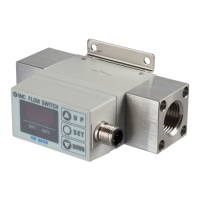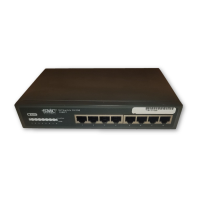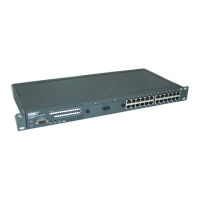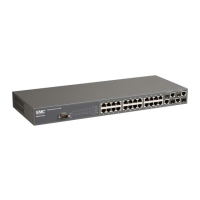2 to 16l/min
0.1
l/min
l/min, gal (US)/min
l, gal (US)
0 to 999999
l
0 to 50°C (with no condensation)
±5% F.S. or less
±3% F.S. or less
±5% F.S. or less (0 to 50°C)
Lights up when ON, OUT1: Green, OUT2: Red
1s or less
Hysteresis mode: Variable (can be set from 0)
Window comparator mode: Fixed (3 digits)
Note 4)
12 to 24VDC (ripple ±10% or less)
50mA or less
45g
Equivalent to IP40
Model
Flow rate measurement and setting range
Minimum setting unit
Accumulated flow range
Operating temperature range
Linearity
Note 2)
Repeatability
Note 2)
Temperature characteristics
Note 2)
Indicator lights
Response time
Hysteresis
Power supply voltage
Current consumption
Weight
Enclosure
Real-time flow rate
Accumulated flow
Display units
Note 1)
Output
specifications
Specifications
PFW300 PFW301PFW310 PFW311 PFW321PFW320
0.5 to 4 (setting is 0.6 to 4) l/min
0.05
l/min
5 to 40
l/min
0.5
l/min
A
B
Mounting
Flow rate range
Panel mount
DIN rail, wall mount
0
1
Output specification
NPN open collector 2 outputs
PNP open collector 2 outputs
1
0
2
0.5 to 4
l/min
2 to 16l/min
5 to 40l/min
Panel mount adapter part no.
Description
Part No.
Panel adapter B
ZS-22-02
How to order
PFW3 00A
Remote Type
Display Unit
Nil
M
With unit switching function
Fixed SI unit
Note)
Unit specification
NPN open collector
PNP open collector
Maximum load current: 80mA
Maximum applied voltage: 30V
Internal voltage drop: 1V or less (with load current of 80mA)
Maximum load current: 80mA
Internal voltage drop: 1.5V or less (with load current of 80mA)
Switch output
Note) Fixed units:
Real-time flow rate:
l/min
Accumulated flow:
l
Note 1) For the type with unit switching function [The type without the unit switching function will have a fixed SI unit (l/min or l).]
Note 2) The system accuracy when combined with PFW5.
Note 3) The output functions operate only for the real-time flow rate display, and do not operate for the accumulated flow display.
Note 4) Window comparator mode — Since hysteresis is 3 digits, separate P1 and P2 by 7 digits or more. 1 digit is the minimum setting unit (refer to the table above).
Note 3)
